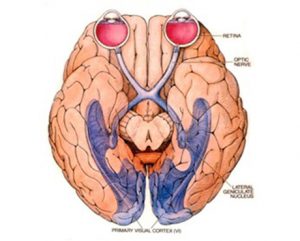
Autism and Vision
Autism Spectrum Disorders and other developmental disabilities can cause them a variety of vision problems, yet many of the children have not received a complete eye evaluation or they are told that their vision is fine. A number of the behaviors which are associated with these spectrum disorders actually has a visual component which when they are addressed, the children’s behavior and the ability to learn and interact with their world will be dramatically improved.
Most people don’t realize that our eyes are actually closely connected to the brain. This is why if someone has a neurological disorder that impacts the brain, their vision would be compromised in some way. Being able to see things clearly from a distance of 20 feet (i.e., “20/20 vision”) is just 1 out of the 15 visual skills required to read, learn and to perform daily activities in life.
In fact, 35 areas of the brain are primarily or totally involved in the processing of visual information. At least 305 intra-cortical pathways link the 35 areas; and, 70% of the sensory information that goes to the brain is visual.
While 1 out of 4 normal children struggles with reading and learning problems are due to the undiagnosed vision problems. Besides, the research also shows that a significantly higher percentage of children with autism spectrum disorders have vision problems which when the problems are corrected, their lives are significantly improved.
In addition, many behaviors that are associated with autism spectrum disorders have a visual component such as watching spinning objects, eyeballing things - getting really close to objects, watching things repetitively, loves looking at shiny objects and has difficulty in locking on or maintaining eye contact. Other behavioral characteristics include disruptive and/or uncooperative behavior, eye contact avoidance, blackboard visual avoidance, poor and uneven handwriting, inability to listen and look simultaneously, overuse of peripheral vision, stiff-legged walk, poking at the sides of his eyes, closing or covering one eye, unable to catch or throw a ball, closes eyes in order to hear.
By treating the underlying vision problem, we find that these children are better able to interact and adapt to their surroundings. By improving the child’s vision causes changes in the neurology and the way the children in understanding their world.
Children who were previously non-verbal, suddenly begin to speak when they are given special glasses that are designed to help them to process their visual information. Some children even stop “eyeballing” things.
Diagnosis and solution of vision problems that impact autism spectrum disorders are performed by developmental optometrists. The emphasis of the testing is designed to determine, “how do we get the child to become more connecting to the world around them?” One of the biggest problems is "Look" (fixate). Visual fixation (looking) is the neuromuscular aiming of the eyes at a specific point in space. For more information about this visual ability please click here.
Solution can often be as simple as a special pair of glasses. For more information, please call our office.


